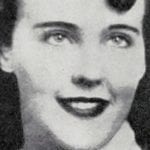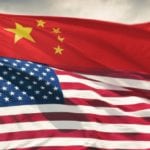 Humans
Humans  Humans
Humans  Gaming
Gaming 10 Overused Game Villains
 Mysteries
Mysteries Ten Mysterious “Ghost Ship” Stories That Still Keep Us Wondering
 Technology
Technology 10 Times AI Replaced Humans (and No One Noticed)
 Politics
Politics 10 Dreaded Despots Who Met Untimely Deaths
 Pop Culture
Pop Culture 10 Celebs Who Have Surprisingly Wanted to Be on Reality TV
 Creepy
Creepy 10 of the Strangest Popular Creepypastas
 Animals
Animals 10 Animals That Used to Be Bigger
 Our World
Our World 10 American Cities, Towns & Villages That Are Unlike Any Other
 Movies and TV
Movies and TV 10 Huge Movies Almost Made by Other Directors
 Humans
Humans 10 Real Life Versions of Famous Superheroes
 Gaming
Gaming 10 Overused Game Villains
 Mysteries
Mysteries Ten Mysterious “Ghost Ship” Stories That Still Keep Us Wondering
Who's Behind Listverse?

Jamie Frater
Head Editor
Jamie founded Listverse due to an insatiable desire to share fascinating, obscure, and bizarre facts. He has been a guest speaker on numerous national radio and television stations and is a five time published author.
More About Us Technology
Technology 10 Times AI Replaced Humans (and No One Noticed)
 Politics
Politics 10 Dreaded Despots Who Met Untimely Deaths
 Pop Culture
Pop Culture 10 Celebs Who Have Surprisingly Wanted to Be on Reality TV
 Creepy
Creepy 10 of the Strangest Popular Creepypastas
 Animals
Animals 10 Animals That Used to Be Bigger
 Our World
Our World 10 American Cities, Towns & Villages That Are Unlike Any Other
 Movies and TV
Movies and TV 10 Huge Movies Almost Made by Other Directors
10 Vital Facts From The Life Of George H.W. Bush
George H.W. Bush was a guy who liked to break records. At 19, he became the youngest commissioned pilot in the entire USA. In 1988, he became the first VP to be elected president since the days of Martin Van Buren back in 1836. In 2000, Bush became the first guy to be both president and father of a president since John Adams. That’s some serious record smashing.
Yet, for all his achievements, Bush Sr. can often feel like the forgotten president. A one-termer sandwiched between Reagan and Clinton, Bush seemed destined for obscurity. Well, we’re here to tell you that there was more to George Herbert Walker Bush than “no new taxes.” In honor of his passing, here are 10 vital facts about the 41st US president.
10 He Nearly Died In World War II

In a parallel universe, you’re not reading this article. Not because you have something better to do (what could possibly be better than visiting Listverse?), but because there never was a President George H.W. Bush. Or a President George W. Bush for that matter. Instead, the George H.W. Bush name was just another casualty statistic from the war in the Pacific, another young man killed by Japanese forces.
In September 1944, Bush was flying a combat mission near the Bonin Islands. The youngest commissioned pilot in the whole of the USA, he was known for his excellent aviation skills. Good job, too, because that was the day he’d need them most. Hit by Japanese antiaircraft fire, Bush’s plane burst into flames.
While most pilots would have chosen that moment to bail out and trust God to save them, Bush did the exact opposite. He kept on flying into the antiaircraft fire. Somehow, he survived long enough to successfully bomb his target and parachute out.[1] For his insane bravery, he was awarded the Distinguished Flying Cross.
9 He Led The Last Successful Military Intervention In US History
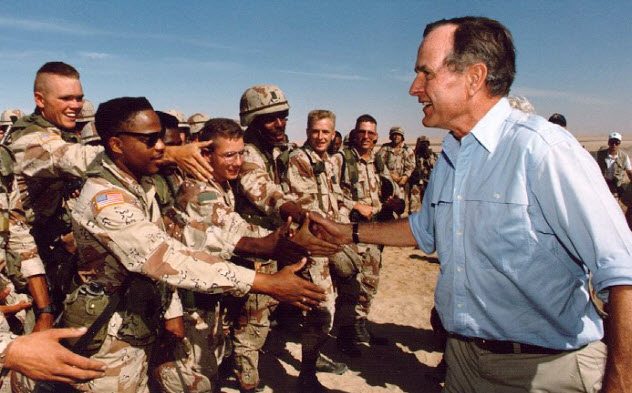
As president, Bush came to be portrayed by hostile Democrats and Republicans alike as a wimp. This seems to be an unfair slur against the former president. Not only had he proved himself in World War II, but he also led the last successful intervention in US history as president.
Today, “military intervention” seems synonymous with catastrophe and getting sucked into a military quagmire. Iraq, Afghanistan, and Libya have all created gigantic messes, while the fight against ISIS was limited to air strikes and providing support to the Iraqi and Kurdish militaries. But US interventions in the Middle East weren’t always useless. The First Gulf War in 1991 succeeded in all its stated goals.[2]
The conflict opened after Saddam’s Iraqi forces invaded Kuwait and threatened to invade Saudi Arabia. With remarkable diplomatic skill, Bush convinced over 30 nations to join him in a coalition against the Iraqi dictator. Despite prewar predictions that thousands of US soldiers would die each day, Saddam was kicked out of Kuwait in six weeks. It was the last time that a US-led conflict would be so quick and easy.
8 His Invasion Of Panama Remains Shrouded In Mystery
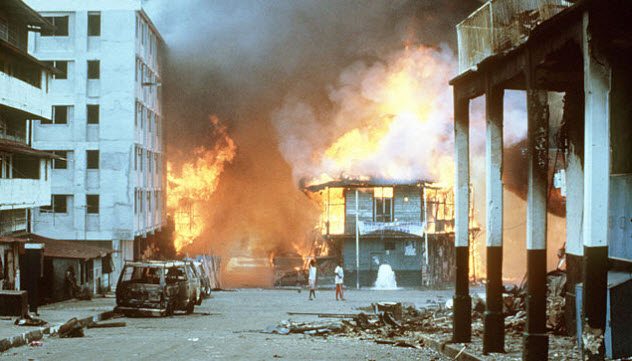
The Gulf War may have been the main event, but it wasn’t the only successful intervention of George H.W. Bush’s presidency. The warm-up act came less than a year into Bush’s sole term.
Relations between the White House and Panamanian dictator Manuel Noriega had been deteriorating rapidly in the late 1980s, culminating in Noriega’s declaration of war on December 15, 1989. The following day, four Americans living in Panama were attacked by government troops. One died. Bush responded by sending in the troops.
The invasion of Panama saw the drug-dealing dictator Noriega deposed and Panama handed over to a civilian government. It was a huge success. However, events were far from clear-cut. Today, we still don’t know for certain what really happened.[3]
In 2016, Panama set up a truth commission to find out how many really died during the invasion. Official estimates vary from the low hundreds to over 1,000. The commission has yet to report back. Until it does, one of the defining moments of Bush Sr.’s presidency will remain shrouded in mystery.
7 He Was Perhaps The Greenest President Ever
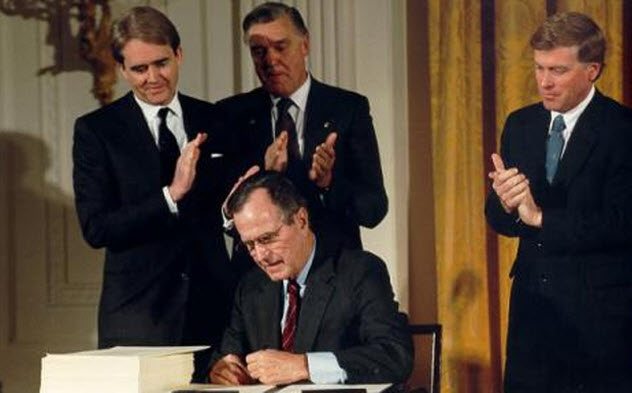
“Republican” and “environmentalist” are not two words that you often associate with each other. Yet George H.W. Bush was proud to be both those things. During his short tenure, he managed to become perhaps the greenest president in US history.
Bush signaled his green credentials early with a 1988 speech that sounded like it had come straight from The Big Book of Democrat Party Talking Points. While politicians say plenty of quickly forgotten things while campaigning, Bush was apparently the real deal.[4]
In 1990, he spearheaded a bipartisan push to amend the Clean Air Act. His changes are perhaps the most significant environmental legislation in US history. They curbed pollution, cut down on smog, and massively improved public health.
In 1992, Bush went even further, getting involved with the United Nations Framework Convention on Climate Change, a hugely important piece of global legislation. Signing it, he said he wanted to make the US a world leader on environmental issues.
6 He Changed Life For Millions Of Disabled Americans
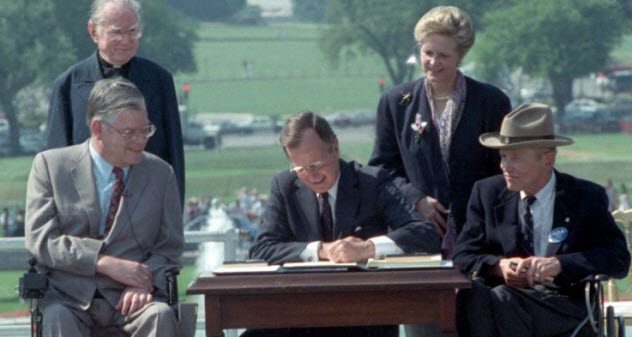
Until 1990, there was absolutely nothing in US law to stop you from discriminating against someone with disabilities. That all changed thanks to the Americans with Disabilities Act (ADA), a bill developed with the help of—you guessed it—George H.W. Bush. Another bipartisan effort, it effectively did for disabled Americans what the Civil Rights Act did for minorities.
Hard as it is to believe now, ADA was massively controversial at the time. Thanks to provisions forcing employers to make work spaces disabled friendly, it was thought that it might wind up damaging businesses. However, it was broadly a success due to some very careful wording. Today, it protects millions of Americans.[5]
If this is all sounding a little vague, here’s an example to help cement how necessary ADA was. In 1993, a security company fired its executive director because he had terminal brain cancer. Thanks to ADA, he was able to sue. Without Bush’s commitment to the bill, he wouldn’t have been able to do squat.
5 Saddam Hussein Personally Ordered Him Killed
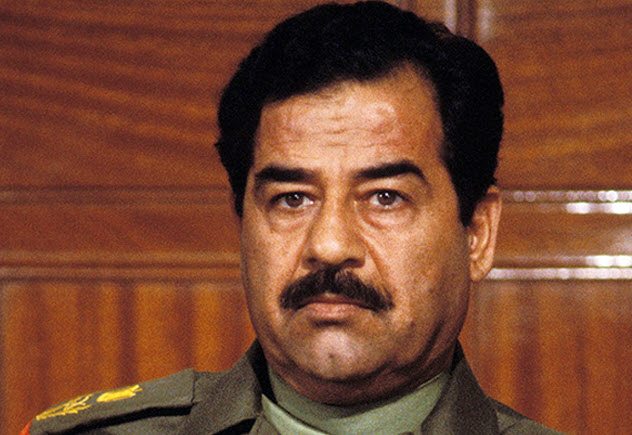
When Saddam Hussein wanted someone dead, that person usually died. Aside from murdering his own population with impunity, Saddam had a nasty habit of sending Iraqi agents abroad to murder foreign opponents.
Following the Gulf War, he had no foreign opponent he wanted dead as much as President Bush. So, in 1993, he gave the order. His men were to assassinate the former president the next time he was in the Middle East. In April 1993, they got their chance.
Bush was in Kuwait to commemorate the victory over Saddam’s forces two years earlier. Simultaneously, 17 Iraqi agents were preparing to kill him. Their weapon of choice wasn’t exactly elegant.
They planned to explode a gigantic car bomb as Bush passed, probably killing dozens in the process. They got to the stage where the car was loaded and ready to roll the next morning when Kuwaiti intelligence finally busted them.[6]
The assassination attempt led to a targeted response from the Clinton White House, which bombed the Iraqi Intelligence Service building in Baghdad, killing around seven. After that, Saddam apparently decided to drop the whole assassination thing.
4 His Record On Eastern Europe Was Mixed
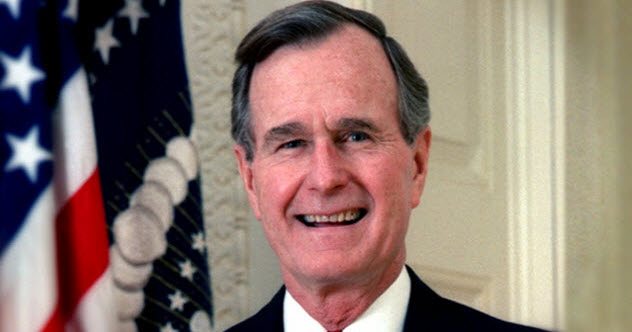
It’s often said that George H.W. Bush’s time in the White House was defined by what was happening abroad. Aside from two invasions, 41 was forced to oversee perhaps the biggest geopolitical shift of the post–World War II era: the utter collapse of the Soviet Union. His efforts were mixed, to say the least.
First, the good. Bush was a skilled diplomat and helped steer Mikhail Gorbachev toward peacefully dissolving the Soviet Union. Bush recognized newly independent nations—such as Latvia, Lithuania, and Estonia—but did so without any gloating that could have caused a major backlash in Moscow. In many ways, his approach was successful.
However, in other ways, he fell short, often by not encouraging newly freed nations toward democracy. His lowest point may have been the “Chicken Kiev” speech in August 1991. He appeared to implore Ukrainians not to leave the Soviet Union. The speech cost him dearly at home, where foreign policy hawks tore him a new one.[7]
3 His ‘No New Taxes’ Blunder Was Hailed As Great Bipartisanship
During the 1988 campaign, Bush made a promise that would come back to haunt him. While making his acceptance speech for the Republican nomination, he said: “Read my lips. No new taxes.” Barely two years later, taxes shot up. The broken promise became emblematic of Bush’s domestic problems and arguably contributed to Bill Clinton winning the ’92 election.
However, there’s one part that everyone misses while telling this story. Bush’s tax hikes weren’t seen by everyone as a betrayal. Many thought they were bipartisanship working at its best.
During Bush’s tenure, Democrats controlled both the Senate and the House. With a recession biting and the deficit ballooning, Bush had no choice but to negotiate. His eventual tax hikes were models of compromise, ensuring that neither party came out looking like the loser.[8]
Unfortunately, campaign staff members for the Democrats and anti-Bush Republicans weren’t interested in that. In the 1992 election, they pummeled Bush over his old sound bite, fixing him forever in the public’s mind as a promise breaker.
2 His Vomiting Incident Was Even Worse Than You Probably Think
Posterity can be cruel. Aside from “no new taxes,” Bush’s White House tenure is probably best remembered today for the embarrassing incident when he barfed all over the Japanese prime minister. The cause of the vomiting was a horrible stomach bug combined with a strenuous work schedule, but no one remembers that now. They just remember the puking.
Remarkably, this is actually a step up from what Joe Public thought in 1992. After the vomit video aired in the US, the media made mincemeat of the president.[9]
At the time, America was in recession and Bush was in the middle of a grueling multination trip trying to drum up trade. Japan’s economy was booming, and it was thought that Tokyo could soon replace Washington as the center of global power.
So Bush’s visit was already seen as kowtowing, even before he vomited. Afterward, it was seen as a horrible metaphor for how America was sick under his leadership and only kept afloat by Japanese support.
Incidentally, the vomiting became a source of humor in Japan, too. For a while, “to Bush” became a verb for throwing up.
1 He Personally Raised Millions For Disaster Relief
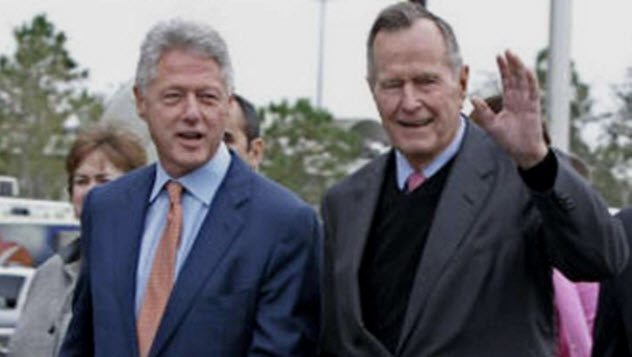
In his post-presidency period, the news mentioned Bush so rarely that you’d be forgiven for thinking that he was unwinding on the golf course. But Bush didn’t slow down once he left the White House. While his son was occupying the Oval Office, Dad was busy teaming up with his old rival Bill Clinton to raise millions of dollars for disaster relief.
The duo first began fundraising in earnest after the devastating Asian tsunami of 2004, which killed around 250,000 people in one of the worst natural disasters in human history. Their private relief efforts were so successful that they were asked to repeat the trick after Hurricanes Katrina and Rita left New Orleans underwater and the southeastern US in dire straits.
Only a few years later, Bush was fundraising yet again, this time for relief from Hurricane Ike.[10] And that’s before we even get to his global work for Save the Children. Overall, he raised hundreds of millions of dollars and changed countless lives.
And that’s the way we should remember former President George H.W. Bush. As a guy who may have been unpopular when he left office, who may have been characterized as a wimp, but who, deep down, was a man of strong moral principles with a backbone so firm that you could use it as a temple pillar. With his passing, America just lost an unheralded giant.
Read about more of the greatest pranks and faux pas by US presidents on 10 Of The Greatest Pranks Pulled Off By US Presidents and Top 10 Faux Pas Committed By US Presidents.

